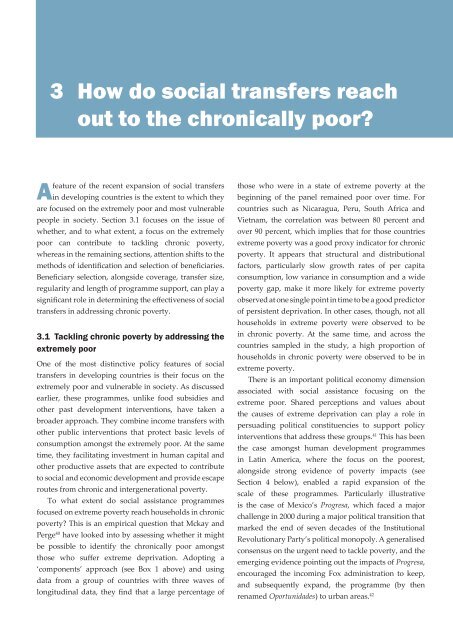Social transfers and chronic poverty
Create successful ePaper yourself
Turn your PDF publications into a flip-book with our unique Google optimized e-Paper software.
3 How do social <strong>transfers</strong> reach<br />
out to the <strong>chronic</strong>ally poor?<br />
feature of the recent expansion of social <strong>transfers</strong><br />
A in developing countries is the extent to which they<br />
are focused on the extremely poor <strong>and</strong> most vulnerable<br />
people in society. Section 3.1 focuses on the issue of<br />
whether, <strong>and</strong> to what extent, a focus on the extremely<br />
poor can contribute to tackling <strong>chronic</strong> <strong>poverty</strong>,<br />
whereas in the remaining sections, attention shifts to the<br />
methods of identification <strong>and</strong> selection of beneficiaries.<br />
Beneficiary selection, alongside coverage, transfer size,<br />
regularity <strong>and</strong> length of programme support, can play a<br />
significant role in determining the effectiveness of social<br />
<strong>transfers</strong> in addressing <strong>chronic</strong> <strong>poverty</strong>.<br />
3.1 Tackling <strong>chronic</strong> <strong>poverty</strong> by addressing the<br />
extremely poor<br />
One of the most distinctive policy features of social<br />
<strong>transfers</strong> in developing countries is their focus on the<br />
extremely poor <strong>and</strong> vulnerable in society. As discussed<br />
earlier, these programmes, unlike food subsidies <strong>and</strong><br />
other past development interventions, have taken a<br />
broader approach. They combine income <strong>transfers</strong> with<br />
other public interventions that protect basic levels of<br />
consumption amongst the extremely poor. At the same<br />
time, they facilitating investment in human capital <strong>and</strong><br />
other productive assets that are expected to contribute<br />
to social <strong>and</strong> economic development <strong>and</strong> provide escape<br />
routes from <strong>chronic</strong> <strong>and</strong> intergenerational <strong>poverty</strong>.<br />
To what extent do social assistance programmes<br />
focused on extreme <strong>poverty</strong> reach households in <strong>chronic</strong><br />
<strong>poverty</strong>? This is an empirical question that Mckay <strong>and</strong><br />
Perge 40 have looked into by assessing whether it might<br />
be possible to identify the <strong>chronic</strong>ally poor amongst<br />
those who suffer extreme deprivation. Adopting a<br />
‘components’ approach (see Box 1 above) <strong>and</strong> using<br />
data from a group of countries with three waves of<br />
longitudinal data, they find that a large percentage of<br />
those who were in a state of extreme <strong>poverty</strong> at the<br />
beginning of the panel remained poor over time. For<br />
countries such as Nicaragua, Peru, South Africa <strong>and</strong><br />
Vietnam, the correlation was between 80 percent <strong>and</strong><br />
over 90 percent, which implies that for those countries<br />
extreme <strong>poverty</strong> was a good proxy indicator for <strong>chronic</strong><br />
<strong>poverty</strong>. It appears that structural <strong>and</strong> distributional<br />
factors, particularly slow growth rates of per capita<br />
consumption, low variance in consumption <strong>and</strong> a wide<br />
<strong>poverty</strong> gap, make it more likely for extreme <strong>poverty</strong><br />
observed at one single point in time to be a good predictor<br />
of persistent deprivation. In other cases, though, not all<br />
households in extreme <strong>poverty</strong> were observed to be<br />
in <strong>chronic</strong> <strong>poverty</strong>. At the same time, <strong>and</strong> across the<br />
countries sampled in the study, a high proportion of<br />
households in <strong>chronic</strong> <strong>poverty</strong> were observed to be in<br />
extreme <strong>poverty</strong>.<br />
There is an important political economy dimension<br />
associated with social assistance focusing on the<br />
extreme poor. Shared perceptions <strong>and</strong> values about<br />
the causes of extreme deprivation can play a role in<br />
persuading political constituencies to support policy<br />
interventions that address these groups. 41 This has been<br />
the case amongst human development programmes<br />
in Latin America, where the focus on the poorest,<br />
alongside strong evidence of <strong>poverty</strong> impacts (see<br />
Section 4 below), enabled a rapid expansion of the<br />
scale of these programmes. Particularly illustrative<br />
is the case of Mexico’s Progresa, which faced a major<br />
challenge in 2000 during a major political transition that<br />
marked the end of seven decades of the Institutional<br />
Revolutionary Party’s political monopoly. A generalised<br />
consensus on the urgent need to tackle <strong>poverty</strong>, <strong>and</strong> the<br />
emerging evidence pointing out the impacts of Progresa,<br />
encouraged the incoming Fox administration to keep,<br />
<strong>and</strong> subsequently exp<strong>and</strong>, the programme (by then<br />
renamed Oportunidades) to urban areas. 42

















